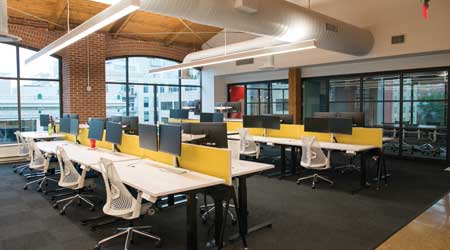 Networked lighting controls support quality lighting by tuning light level, brightness, and color output.
Networked lighting controls support quality lighting by tuning light level, brightness, and color output.8 Important Benefits of Networked Lighting Controls
The benefits of advanced lighting controls extend well beyond energy efficiency. Here is a long list of ways lighting controls can improve your facility.
Networked lighting control systems are designed for data communication. Input from sensors and manual overrides is sent to lighting controllers, which send native output commands to power controllers. Increasingly, these systems are designed with the expectation that this data will be shared.
Control software can be used to profile energy consumption for a variety of purposes. Many systems allow interfacing with other building systems using a native protocol like BACnet or via some type of gateway functionality. As the B-IoT develops, lighting sensor data can be leveraged for broader application either through expanding control software or third-party apps via application programming interfaces (APIs). Additionally, other sensors, badge scan, calendars, and Wi-Fi can be tied to the system to produce greater operating data.
A range of distinct capabilities is available today or in development:
1. Maintenance. Many centralized networked lighting control systems provide monitoring capability. The system may send alarm notifications via email, text, or other method about issues requiring attention. It may also produce daily reports of equipment requiring servicing or replacement. Typically, the system allows multiple recipients, with the ability to customize notifications for each. This capability can make maintenance operations more responsive and efficient, particularly in complex applications such as outdoor lighting.
2. Space utilization. Building owners and facility managers with large portfolios are familiar with integrated workplace management systems, which leverage sensor networks. Networked lighting control systems offer this capability for smaller portfolios and multisite enterprise portfolios, which would benefit from the same analytics. Examples include space planning to optimize usage (e.g., are offices vacant? what store aisles get lower traffic than others?); room availability (are meeting rooms occupied when reserved and can users see this remotely?); custodial reporting (e.g., what spaces require cleaning because they were used? when should cleaning occur to minimize interruptions?); and leasing/utility management (e.g., is the lease satisfying traffic needs? are unused spaces being heated or cooled?). Beyond these examples, even more potential exists in sharing data with other systems such as security, shading, HVAC, elevators, and others.
3. Asset tracking. Some systems enable location of inventory within a facility. For example, in a hospital where wheelchairs and emergency equipment are assigned RFID tags, these items can be tracked via the lighting system operating with an app on mobile devices.
4. Indoor positioning. As luminaires are in every space of a building, they offer a platform for indoor positioning and communications. This can be particularly useful for large applications such as warehouses and big box retail. With an app, users can see where they are and how to get what they want. The owner can then send them targeted communications, such as coupons and promotions.
5. Demand response. The networked lighting control system may have the capability to interface with an automated demand response server. This allows the lighting system to participate in utility demand response programs, which aim to reduce peak power demand, particularly during emergency grid events. In certain locations, energy codes require an automatic minimum power reduction of 15 percent, which may be achievable in many lighted spaces without disruption to operations.
6. Lighting quality. The lighting system’s primary purpose is to provide comfortable visual conditions for completing tasks efficiently and safely, while shaping attention and perception. Networked lighting controls support quality lighting by enabling control of light level, spatial brightness, and color output, with the potential for users to set their local lighting preference. Monitoring ensures lighting is provided without interruption while providing data that facility managers can use to gain insight into user preferences, which in turn can be valuable for future lighting designs.
7. B-IoT. Theoretically, sensors could be added to luminaires to measure anything. For example, in an outdoor lighting system, sensors could collect data on anything from carbon monoxide to snowfall.
8. Light and health. Driven by demand for healthy workspaces embodied in standards such as WELL, the lighting industry is developing best practices for how to address our growing understanding of the relationship between light and human circadian health. Networked lighting controls can play a major supportive role by enabling lighting to be assigned recipes for providing the right intensity and spectrum for the right amount of time at the right time of day.
Welcome to the future
Lighting controls have been a staple in new construction for years, and new control capabilities enabled by LED lighting are finding broad application. As all lighting must be controlled, controls are always the right choice, and what remains is finding the right controls for the application at hand. Among many options, the ultimate choice uses networking, intelligence, and data, not only to maximize energy savings and flexibility, but also to promote quality of light and produce actionable operational intelligence. These capabilities are the key to unlocking extraordinary value in buildings by shifting lighting from a utility to a productive asset. The ideal time to consider taking advantage of lighting control is during an upgrade to LED lighting so as to minimize costs and leverage the capabilities of the light source.
Craig DiLouie is education director for the Lighting Controls Association (www.LightingControlsAssociation.org), a council of the National Electrical Manufacturers Association dedicated to educating the public about lighting controls.
Related Topics:














